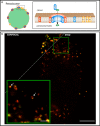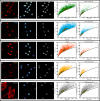Super-resolution Microscopy Reveals Compartmentalization of Peroxisomal Membrane Proteins
- PMID: 27311714
- PMCID: PMC5016101
- DOI: 10.1074/jbc.M116.734038
Super-resolution Microscopy Reveals Compartmentalization of Peroxisomal Membrane Proteins
Abstract
Membrane-associated events during peroxisomal protein import processes play an essential role in peroxisome functionality. Many details of these processes are not known due to missing spatial resolution of technologies capable of investigating peroxisomes directly in the cell. Here, we present the use of super-resolution optical stimulated emission depletion microscopy to investigate with sub-60-nm resolution the heterogeneous spatial organization of the peroxisomal proteins PEX5, PEX14, and PEX11 around actively importing peroxisomes, showing distinct differences between these peroxins. Moreover, imported protein sterol carrier protein 2 (SCP2) occupies only a subregion of larger peroxisomes, highlighting the heterogeneous distribution of proteins even within the peroxisome. Finally, our data reveal subpopulations of peroxisomes showing only weak colocalization between PEX14 and PEX5 or PEX11 but at the same time a clear compartmentalized organization. This compartmentalization, which was less evident in cases of strong colocalization, indicates dynamic protein reorganization linked to changes occurring in the peroxisomes. Through the use of multicolor stimulated emission depletion microscopy, we have been able to characterize peroxisomes and their constituents to a yet unseen level of detail while maintaining a highly statistical approach, paving the way for equally complex biological studies in the future.
Keywords: STED microscopy; membrane protein; membrane trafficking; microscopy; peroxisome; protein import; super-resolution optical microscopy.
© 2016 by The American Society for Biochemistry and Molecular Biology, Inc.
Figures








References
-
- Kunau W.-H. (2006) Peroxisomes: morphology, function, biogenesis and disorders. Biochim. Biophys. Acta 1763, 1363–1808
-
- Islinger M., Grille S., Fahimi H. D., and Schrader M. (2012) The peroxisome: an update on mysteries. Histochem. Cell Biol. 137, 547–574 - PubMed
-
- Braverman N. E., and Moser A. B. (2012) Functions of plasmalogen lipids in health and disease. Biochim. Biophys. Acta 1822, 1442–1452 - PubMed
Publication types
MeSH terms
Substances
Grants and funding
LinkOut - more resources
Full Text Sources
Other Literature Sources

